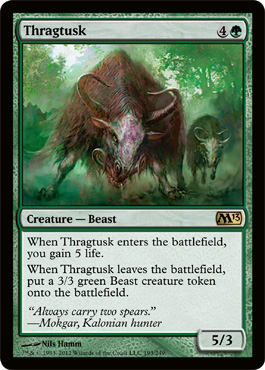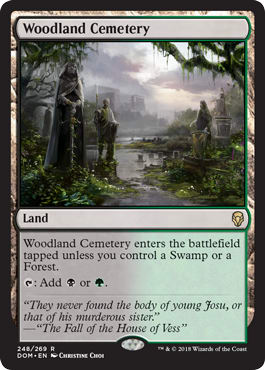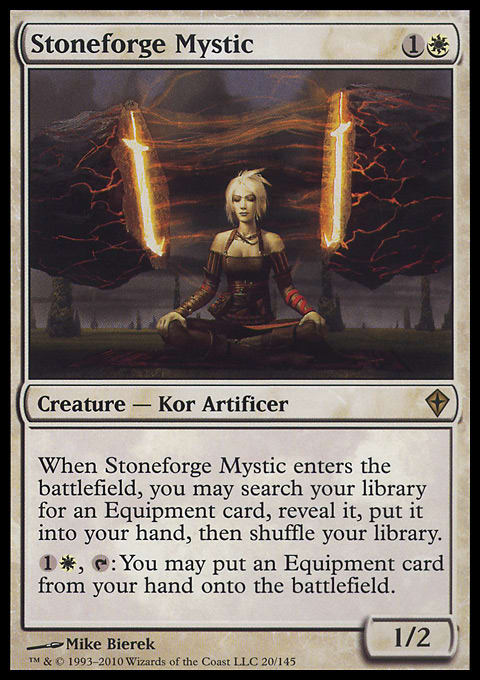The topic for today is a user-submitted question—or in this case: questions—I received last week. This is what Lee Tran had to say:
In the past on MTGO, I haven’t kept track of the rares that become central to a format and what kind of price history it created. I am curious—what's the possible price ceiling in a situation like this where there are no event decks to increase the supply? If there is still significant room for growth, is it a bad idea to rebuy and wait to resell? Thanks for your advice and insight!
P.S. This is kind of off-topic, but reading a forum the other day got me thinking about it, and I'd like your opinion. If there are not any strong answers in Gatecrash to Thragtusk and Standard stagnates out, is there any real possibility that Thragtusk could be banned?
Before I get too far into this, it should be noted that I am by no means a Magic Online expert. I do play avidly, but as far as profiting, I leave that to the cardboard version. I have made some buys similar to Lee’s over the past few years and had great success overall, including cards such as Knight of the Reliquary, Tarmogoyf, and most recently the Innistrad duals. As for a price ceiling, I believe new precedence has been set this past year for what the ceiling on a rare is, both online and in the physical market.
Lee mentions the lack of Event Decks on Magic Online, and I think that although that is probably a factor for the price spike, it is not one of major impact. Unlike physical Magic, the online market moves at a far faster rate, and due to a number of factors, this means a card can rise or fall without the help of a major event. One of the main factors that has held the price of rares down in the digital world is the sheer number of Limited events that are constantly firing.
At your local store, it is likely that there is a very finite number of Limited events each week, if any, meaning your player base will probably have to bust boxes to open the rares everyone is looking for. Although most people will argue that you can buy singles from the shops or online, those cards had to be bought from someone, and that someone probably opened them in a pack. If your local store does not have the cards you need for that night’s event, you are out of luck since shipping can take up to a week from any major website. This inhibiter allows for prices to reach higher peaks than in the digital world since cards are not as readily available.
Another factor that allows online prices to remain cheaper for the average rare is the fact that you can build decks from the same four copies of a card. Even if you have three Standard decks and six Commander decks all running the same card, you still can make use of just that one play set. This is true in physical Magic as well, but it is far less likely someone will want to tear apart his Standard deck to play a game of Commander or vice versa.
The last major factor that I can see driving the price of physical cards over digital items is the fact that the online market is far more expansive. At any time, you can enter the marketplace and find any number of dealers selling almost every card. Though this may not sound different than the real world, the fact that you or I can set up a posting in seconds to sell our cards cheaper than a bot means that the market is extremely competitive. The margin between the ins and outs for dealers in the physical world is far greater than in the digital world because of how much more time and effort you have to put into a brick-and-mortar store or website. Whenever something is automated, you will see a decrease in the price, no different than when looking at the cost of any real-world object now as opposed to when it used to be handmade.
So, what do all of the above factors have to do with the maximum price of rares on Magic Online? I wanted to show the difference between the two platforms before I discussed actual ceilings so there would be a better understanding of from where I am drawing my conclusion. To answer your original question, I believe Thragtusk is probably going to hold solid around the $15 mark. Although M13 is being drafted very little, it is still a readily available set that has some other cards in it that are now picking up popularity, making the packs less of abominations in terms of value. I can see the card spiking to $20 near Pro Tour Qualifier times, but I don’t foresee that price holding until the set is no longer opened at all.
I do not believe this will change the typical price of a Magic Online rare, and this is one of the rare instances in which a card can hold over $10 for an elongated period of time. The reason Thragtusk has made such a special case is not based solely on how format-defining it is, but also on the fact that it can be, and is, played in so many different decks. Unlike cards such as Stoneforge Mystic or Umezawa's Jitte, Thragtusk has the ability to fit in anything from midrange to control, and in some cases, it is almost solely the reason to go green at all. Though the format is certainly defined by the number of Thragtusks one can resolve in a game, it is unlike almost every other format that has received such broken cards in the sense that the card can fit into multiple decks.
Since Thragtusk has been showing his ugly head all across the metagame, what does that mean for the future of Standard, and is he a potential ban in the coming months? When evaluating this question, I first came to the snap answer of: Yes, he could potentially be banned since he has seemed to slow the format to a grinding halt, taking almost every round from a Grand Prix to a Friday Night Magic the full amount of time. After looking at the situation a little deeper, I began to question my initial ideas and have honestly found no real reason to ban him. I would like to see something in Gatecrash that can answer the stalling issue, but I do not believe the format has become stale enough to warrant a ban at this point.
If the metagame finds a deck that dominates the rest of the field and relies on Thragtusk as the keystone of its plans, I could see this question being reevaluated, but for now, I do not see Thragtusk getting the axe. While certainly the most defining creature in Standard, the fact that he costs 5 and does not actually win the game for you or break the format—such as cards like Skullclamp—will keep him safe. Although he’s certainly one of the best green creatures ever printed and is likely to make an impact across formats for the coming years, I do not see a Standard without Thragtusk in it.
If anyone out there is a Magic Online expert and would be willing to either sit down at an event for an interview or do an e-mail interview, please contact me. I would love to provide the readers with more of an insight into the market, and unfortunately, I am ill-equipped to do so. You can stay anonymous if you would prefer, and even if you just know one facet of Magic Online in depth, I would still like to ask a few questions.
That’s all I have for this week. Next week, we have another theme week here on GatheringMagic, in which I have the wonderful challenge of tying one of these guilds to the financial side of Magic. The week after that, I am going to take a look back at my predictions for Return to Ravnica and give you the opportunity to poke fun at all the mistakes I made—I mean, what else is the Internet for, right? I hope to see some of you in Chicago this weekend at the Grand Prix. If you are there, come say “hello” and introduce yourself; I always love meeting readers and hearing your input. Thanks again for reading, and I look forward to the continual submissions in the Modern Masters contest.
Ryan Bushard


























